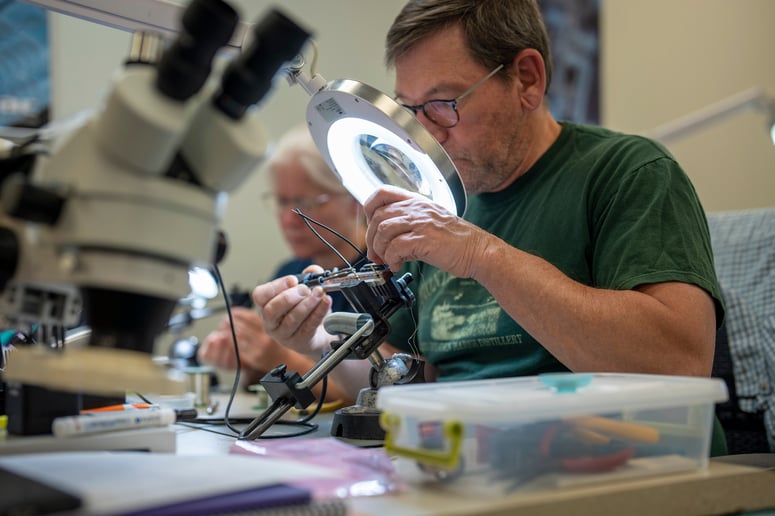Hand soldering is a vital skill in the world of electronics, offering a versatile solution for creating and repairing electronic connections. Despite the advent of automated soldering methods, the art of hand soldering remains indispensable, especially for custom, small-scale, and precision tasks. In this comprehensive blog article, we delve into the techniques, applications, and the EPTAC’s training for hand soldering.

Techniques of Hand Soldering
Hand soldering is characterized by a variety of techniques, each suited for different types of tasks and components. Some of the prominent techniques include:
- Through-Hole Soldering
This technique involves soldering components with leads that pass through holes on a printed circuit board (PCB). The solder is applied to the joint where the lead exits the board, securing and electrically connecting the component to the PCB. Used for mounting through-hole components like resistors, capacitors, and connectors.
- Surface Mount Soldering
Components are placed directly onto the surface of the PCB, and solder is applied to the pads to secure and connect them. It requires precision as the components are often small and close together. Ideal for surface mount devices (SMDs) like microcontrollers, resistors, and capacitors.
- Drag Soldering
The soldering iron tip is dragged across multiple leads of a component, allowing for quick soldering of several joints. It’s often used for components with many pins, like integrated circuits. Suitable for soldering ICs, connectors, and other multi-pin components.
- Reflow Soldering (Manual)
Solder paste is applied to the pads on the PCB, and components are placed on top. Heat is then applied using a hot air gun or another heat source to melt the solder paste and form joints. Commonly used for surface mount components and BGA (Ball Grid Array) packages.
- Point-to-Point Soldering
Involves soldering individual wires or component leads directly to each other or to terminal points, without a PCB. It’s a traditional method often used in vintage electronics and custom builds. Used in custom electronics, repairs, and vintage restorations.
- Tack and Reflow Technique
Components are initially ‘tacked’ in place with a small amount of solder to hold them steady. The rest of the soldering is completed afterward, ensuring components remain aligned. Helpful for precision tasks and small, delicate components.
- Flood and Wick Technique
Excess solder is intentionally applied and then removed with a desoldering wick to ensure all joints are filled. It’s a corrective technique for ensuring proper connections. Used for correcting solder bridges and ensuring full solder joints.
- Heated Tweezers Technique
Utilizes tweezers with heated tips to simultaneously heat both ends of a small component, allowing for easy placement and removal. Ideal for small two-terminal components like resistors, capacitors, and diodes.
- Hot Air Pencil Technique
Uses a hot air pencil to melt solder, allowing for the placement or removal of components. It provides even heating and is often used for rework and repairs. Suitable for SMDs, QFN (Quad Flat No-leads), and other complex packages.
- Solder Bridge Technique
Involves intentionally creating solder bridges between adjacent leads or pads and then removing excess to leave behind the desired amount of solder. Often used for ICs and multi-pin connectors to ensure all pins are soldered.
Each technique has its own set of advantages and is suited for different types of tasks. The choice of technique depends on factors like the type of components, the complexity of the task, and the level of precision required. Proper training and practice are essential to master these techniques and ensure quality soldering results.
Applications of Hand Soldering
Hand soldering finds its applications across various industries, including:
- Electronics Repair
Fixing and restoring electronic devices by replacing or re-soldering components.
Examples: Repairing circuit boards, smartphones, computers, and other electronic gadgets.
- DIY Electronics Projects
Building and assembling electronic circuits and devices as personal projects.
Examples: Making LED displays, Arduino projects, Raspberry Pi-based systems.
- Prototype Development
Creating prototypes of electronic devices for testing and evaluation.
Examples: Developing prototypes for new gadgets, testing circuit designs.
- Educational Purposes
Teaching and learning about electronics and soldering techniques.
Examples: Educational kits, classroom projects, student experiments.
- Automotive Electronics
Repairing and installing electronic systems in vehicles.
Examples: Fixing car audio systems, installing alarms, repairing electronic controls.
- Aerospace and Defense
Assembling and repairing electronic systems in aircraft and defense equipment, where precision and reliability are critical.
Examples: Soldering components in avionics, military communication devices.
- Consumer Electronics Manufacturing
Small-scale assembly or modifications in the manufacturing of consumer electronics.
Examples: Assembling circuit boards for gadgets, wearable tech.
- Custom Cable Assembly
Creating custom cables and connectors for specific applications.
Examples: Making custom audio cables, specialized connectors.
- Art and Jewelry Making
Using soldering to create metal art, sculptures, and jewelry.
Examples: Crafting jewelry, metal art pieces.
- Model Railroading and Miniatures
Building and repairing electronic systems in model trains and miniature setups.
Examples: Installing lights and controls in model railroads.
- Robotics
Assembling and repairing electronic circuits in robots.
Examples: Building robots, drones, and automated systems.
- Medical Devices
Assembling and repairing electronic components in medical equipment.
Examples: Fixing medical monitors, diagnostic equipment.
- Research and Development
Developing new electronic devices and systems in research labs.
Examples: Experimental electronics, new technology development.
- Hobbyist Activities
Various hobbyist activities that involve creating or repairing electronic devices.
Examples: RC cars, planes, ham radio.
Each application requires a specific set of skills and knowledge to ensure that the soldering is done effectively and safely. Hand soldering is particularly popular for tasks that require a high level of precision, flexibility, and control.
EPTAC's Role in Boosting Hand Soldering Expertise
EPTAC is one of the key players in providing quality training for hand soldering, offering courses that combine theoretical knowledge with practical skills. Here are three EPTAC’s courses on hand soldering:
This program is centered around imparting foundational soldering knowledge and hands-on skills. It covers a range of technologies including Wires and Terminals, Through-Hole and Surface Mount soldering, and Lap Solder joints. Participants are introduced to the nuances of Through-Hole and Surface Mount Rework, offering a comprehensive learning experience.
The course is highly practical, with about 75% of the time dedicated to hands-on activities. Attendees work with both lead and lead-free alloys, soldering practice pieces and inspecting them before submission for instructor feedback. The final workmanship pieces are graded for certification, ensuring that participants meet the Class 3 criteria, indicative of the highest quality standards in the industry.
The flexibility of the course allows for customization, enabling attendees to select specific days or modules that align with their training needs, ensuring a tailored learning experience that is both comprehensive and relevant.
This advanced two-day program is specifically designed for professionals who work with ultra-small surface mount components. The course covers the placement, soldering, and rework of fine pitch surface mount components, including chip components sized 0603, 0402, 0201, and 01005, as well as multi-leaded extra fine pitch devices.
With a strong emphasis on hands-on experience, participants spend approximately 75% of the course time practicing the techniques to perfect their skills. Soldering exercises are conducted in both lead and lead-free environments, offering a comprehensive understanding of the different alloys' impacts.
The course also includes discussions on micro-component placement and the process of making electrical connections with a soldering iron or hot air gasses. Topics such as fluxes, solder selection, and the soldering process are reviewed to give students a well-rounded understanding of the tools, materials, and procedures involved.
Note: This is an advanced program, and participants are required to have completed EPTAC’s Surface Mount Soldering Certification program or a similar program. Verification of prior certification and current soldering skills is mandatory for enrollment.
The 1-day Hand Soldering Certification Recertification course offered by EPTAC is tailored for individuals looking to renew their existing credentials. Participants will engage in a comprehensive review of the fundamental soldering criteria and undertake hands-on soldering workmanship exercises in the specific modules required for renewal. This streamlined approach ensures that professionals can efficiently refresh and validate their skills, maintaining their certification’s validity and relevance. Notably, EPTAC accommodates professionals with third-party soldering certifications, granting recognition to those credentials provided they are less than 2 years old, showcasing flexibility and inclusivity in their recertification process.
EPTAC’s courses are structured to ensure participants leave with both the knowledge and practical skills needed for quality hand soldering in various applications. Each course is designed with a focus on real-world applicability, preparing participants for the challenges they’ll face in their professional tasks.
About EPTAC
EPTAC is an internationally recognized leader in solder training and IPC certification, providing professionals with the skills to accelerate their careers, and businesses, the talent to succeed. For over 35 years, EPTAC has been helping corporations increase quality standards, improve productivity, and maximize profits. With 24 locations in North America, EPTAC continues to expand its offerings and exceptional instructional staff to provide easy access to knowledge and skill-based programs when and where the industry demands it. Access our scheduled programs through our website or schedule your own corporate on-site training. For information, call 800.643.7822 or contact us.




